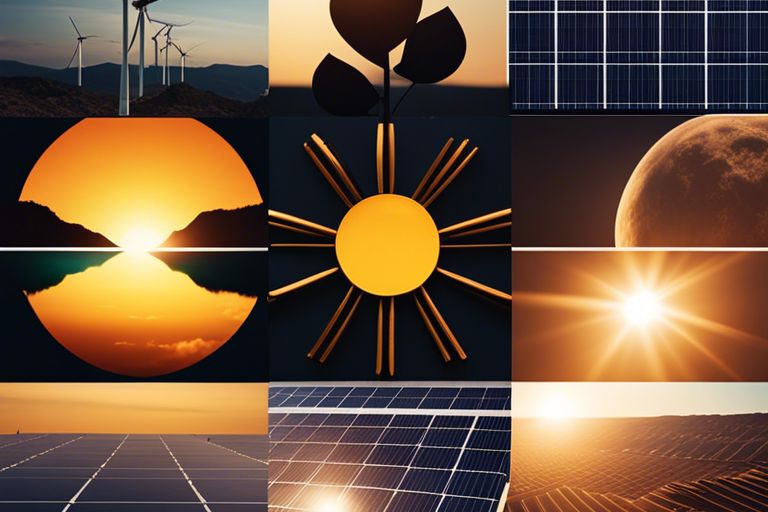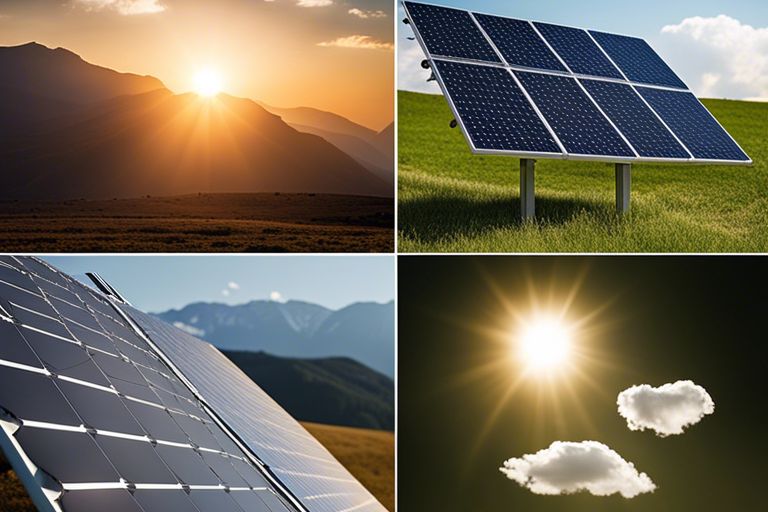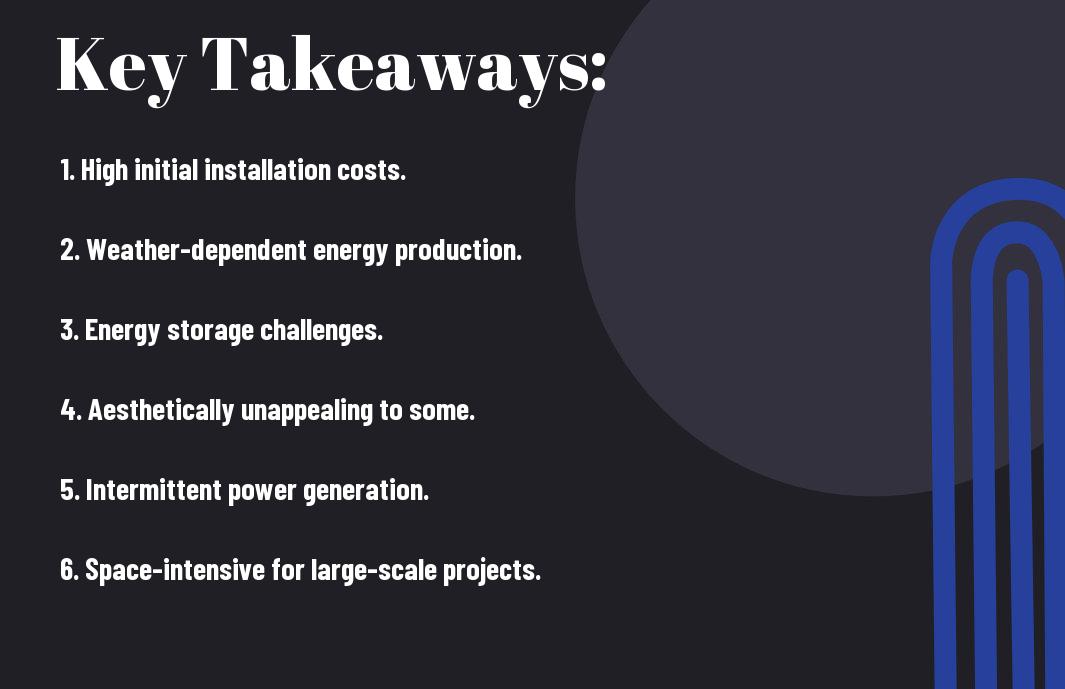Efficiency is a key consideration when looking into solar energy. While solar power has numerous benefits, it’s vital to be aware of its downsides. From initial costs to weather dependency, there are several drawbacks to consider before making the switch to solar energy. In this article, we will probe into 10 disadvantages of solar that you should keep in mind before investing in this renewable energy source.
Key Takeaways:
- Intermittency: Solar energy production is not constant and varies based on weather conditions, time of day, and season.
- Upfront Costs: Installation of solar panels can be expensive, and the initial investment may not be feasible for everyone.
- Space Requirements: A significant amount of space is needed to install solar panels, which may not be practical for all property types.
High Upfront Costs
Initial Investment
The initial investment for a solar energy system can be one of the main disadvantages. An upfront cost is required to purchase and install the solar panels, inverters, batteries, and other necessary equipment. Depending on the size of your system and energy needs, this initial investment can be quite significant. This cost can sometimes deter homeowners from choosing solar energy as an option.
Installation Expenses
Aside from the equipment costs, installation expenses can also add to the overall upfront costs of a solar energy system. Hiring professionals to install the system properly is crucial for optimal performance and safety. These installation costs can vary depending on the complexity of the installation, the size of the system, and any additional features or accessories you may want to include.
The installation expenses for a solar energy system can include labor costs, permit fees, inspection costs, and any necessary upgrades to your property to accommodate the solar panels. It’s necessary to factor in all these costs when considering the investment required for a solar energy system.

Intermittent Energy Source
Even though solar energy is a renewable resource, one of the major disadvantages is that it is an intermittent energy source. This means that solar power can only be generated during the daytime when the sun is shining. At night or during cloudy days, solar panels are not able to produce electricity, leading to a fluctuating energy supply.
Dependence on Weather Conditions
Conditions such as clouds, fog, or rain can greatly impact the amount of sunlight reaching the solar panels, thereby affecting the energy output. This dependence on weather conditions makes solar energy less reliable compared to traditional sources of energy that are available consistently.
Unreliable Power Supply
On top of being dependent on weather conditions, the intermittent nature of solar energy also results in an unreliable power supply. This inconsistency can pose challenges for power grids that require stability to meet the energy demands of households and industries. During periods of low sunlight, alternative sources of energy or energy storage systems are necessary to ensure a continuous power supply.
Space Requirements
Once again, if you’re considering installing solar panels on your property, you need to understand the space requirements involved. According to The Pros and Cons Of Solar Energy (2024 Guide), one major disadvantage of solar energy is the large land area needed for solar farms to generate a significant amount of electricity efficiently.
Large Land Area Needed
To harness solar energy on a large scale, extensive land is required to accommodate the solar panels. This can be a significant drawback, especially in urban areas where space is limited and expensive. Additionally, setting up solar farms in remote locations can lead to issues with infrastructure development and maintenance costs.
Roof Space Constraints
Large roof space constraints can also pose a challenge for residential solar panel installations. Depending on the size and design of your roof, you may not have enough space to fit an adequate number of solar panels to meet your energy needs. This limitation can restrict your ability to fully harness the benefits of solar energy for your home.
This limitation can be particularly problematic for homeowners who want to maximize their energy savings by generating as much solar power as possible. If your roof has limited space or is shaded by trees or other buildings, you may have to explore alternative solutions such as ground-mounted solar panels, which can be more costly and require additional land.
Energy Storage Issues
After reading about the Disadvantages of Solar Energy, you must consider the energy storage issues that come with relying on solar power.
Battery Costs and Maintenance
The costs and maintenance of solar batteries can be a significant disadvantage when it comes to solar energy. Batteries used to store excess energy generated by solar panels can be expensive to purchase and maintain. Over time, these batteries may need to be replaced, adding to the overall cost of a solar energy system. Additionally, regular maintenance is required to ensure the batteries are functioning efficiently and safely.
Limited Capacity and Efficiency
One downside to solar energy is the limited capacity and efficiency of energy storage systems. While solar panels can generate electricity during the day when the sun is shining, you may not always have access to that energy when you need it most, such as during the night or on cloudy days. This limited capacity and efficiency can be a drawback for those looking to rely solely on solar power.
Capacity must also be considered when looking at energy storage issues with solar power. The amount of energy that can be stored in batteries is limited, meaning you may not always have access to a reliable source of power when the sun is not shining. This can be a significant disadvantage for those who require constant access to electricity.
Inefficiency of Solar Panels
Despite the numerous benefits of using solar energy, there are several disadvantages to consider. One of the main drawbacks of solar panels is their inefficiency in converting sunlight into usable electricity.
Energy Conversion Rate
One issue with solar panels is their energy conversion rate, which refers to the percentage of sunlight that is converted into electricity. Most solar panels on the market today have an efficiency rate of around 15-20%. This means that a large portion of the sunlight that hits the panels is not converted into usable energy, resulting in wasted potential.
Heat-Related Efficiency Loss
Efficiency loss due to heat is another concern with solar panels. As the temperature of the panels increases, their efficiency in converting sunlight into electricity decreases. This is because the heat can cause the electrons in the solar cells to move more slowly, resulting in a reduction in overall energy production.
With this decrease in efficiency, you may not be getting the maximum energy output from your solar panels, especially during hot summer months when the sunlight is strongest. This heat-related efficiency loss can limit the overall effectiveness of your solar energy system and impact your energy savings in the long run.
Environmental Impact
Many environmental concerns are associated with the production and installation of solar panels. These concerns revolve around the manufacturing process emissions and the land use and habitat disruption caused by solar farms.
Manufacturing Process Emissions
Process emissions from the manufacturing of solar panels release greenhouse gases and other pollutants into the atmosphere. The production of solar panels involves the use of various chemicals, including silicon, cadmium, and lead, which can have harmful effects on the environment. Additionally, the energy-intensive nature of the manufacturing process contributes to carbon emissions, offsetting some of the environmental benefits of using solar energy.
Land Use and Habitat Disruption
Habitat disruption occurs when large areas of land are cleared to make way for solar farms. This can have a significant impact on local ecosystems and wildlife habitats. The installation of solar panels can lead to the loss of vegetation and disruption of natural habitats for various species. Additionally, the construction of solar farms can fragment landscapes and disrupt migration patterns of wildlife.
Manufacturing solar panels also requires a significant amount of land, which can further contribute to habitat disruption. As the demand for solar energy continues to grow, more land will be needed for the production and installation of solar panels, potentially leading to further environmental impact.
Technical Limitations
Inverter and Converter Issues
Limitations in solar technology include issues with inverters and converters. These components are crucial for converting the direct current (DC) generated by solar panels into alternating current (AC) used in homes and businesses. However, inverters and converters can be costly to purchase and maintain. They also have a limited lifespan compared to solar panels, which means you may need to replace them more frequently, adding to the overall cost of your solar power system.
Grid Connection Challenges
An additional technical limitation of solar energy is the challenge of connecting your solar power system to the grid. While you can sell excess electricity back to the grid through net metering programs, the process of connecting to the grid can be complex and costly. You may need to invest in additional equipment and meet specific requirements set by utility companies, which can deter some homeowners from adopting solar energy.
Grid connection challenges can also lead to delays in getting your solar system up and running, further adding to the time and effort required for installation. It’s important to research and understand the grid connection process in your area before investing in solar energy to avoid any unexpected complications.

Maintenance and Repair
Unlike other forms of energy generation, solar panels require regular maintenance and repair to ensure optimal performance. This can be a disadvantage for some homeowners who may not have the time or resources to keep up with the necessary tasks.
Regular Cleaning and Inspection
Maintenance of solar panels involves regular cleaning and inspection to remove dirt, debris, and any shading obstructions that may affect their efficiency. You need to ensure that the panels are clean and free from any blockages to maximize their energy production. This can be time-consuming, especially if your panels are installed in an area prone to dust or pollution.
Component Replacement and Repair
Cleaning the solar panels is vital, but over time, certain components may need to be replaced or repaired due to wear and tear. This can include inverters, batteries, wiring, or even the panels themselves. You need to have a professional assess and fix any issues to keep your solar system running smoothly. This additional maintenance cost and hassle can be a drawback for some homeowners.
Understanding the maintenance requirements and potential repair costs of a solar energy system is crucial before investing in one. By staying on top of regular cleaning and inspections, as well as being prepared for possible component replacements, you can mitigate some of the disadvantages associated with solar panel maintenance and repair.

Conclusion
Ultimately, when considering whether or not to invest in solar energy, it’s important to weigh the disadvantages along with the benefits. While solar energy offers numerous advantages, including sustainability and cost savings, it also comes with its own set of drawbacks. By understanding the ten disadvantages outlined in this article, you can make a more informed decision about whether solar energy is the right choice for your home or business.
Keep in mind, every situation is unique, and what may be a disadvantage for one person or business may not be a concern for another. By carefully evaluating the disadvantages of solar energy and how they may impact your specific circumstances, you can make a more educated decision that aligns with your goals and values. Whether you decide to go solar or explore other energy options, the key is to make a choice that best suits your individual needs and priorities.
Q: What is the first disadvantage of solar energy?
A: The initial cost of installing a solar energy system can be high, making it less accessible for some individuals or businesses.
Q: What is the second disadvantage of solar energy?
A: Solar panels require a significant amount of space for installation, which may be a limitation for those with limited roof space or land area.
Q: What is the third disadvantage of solar energy?
A: Solar energy production is intermittent and dependent on weather conditions, making it less reliable than traditional power sources like coal or nuclear energy.
Q: What is the fourth disadvantage of solar energy?
A: Solar panels can be affected by shading, dust, or debris, which can reduce their efficiency and output capacity.
Q: What is the fifth disadvantage of solar energy?
A: Energy storage solutions like batteries are required for solar systems to provide electricity during nighttime or cloudy days, adding to the overall cost of the system.
